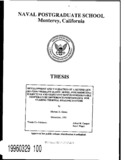A comparison of computational cognitive models : agent-based systems versus rule-based architectures

Download
Author
Oeltjen, Craig L.
Date
2003-03Advisor
Darken, Rudolph
Second Reader
Peterson, Barry
Metadata
Show full item recordAbstract
Increased operational costs and reductions in force size are two of the major factors driving the need for improved computer simulations within the military community. Human performance models are used in various aspects of simulation, including controlling computer generated forces, tactical decision aides, intelligent tutoring systems and new system design. This research makes a comparison between two categories of human performance models, multi-agent systems and rule-based architectures. Each type of model has its own strengths and weaknesses, and is therefore better suited for certain applications. Complex military simulations need human performance models that take advantage of the strengths of more than one type of model. The purpose of this research is to compare the implementation and performance of these two models, and to demonstrate the need for hybrid systems that employ the best aspects of models for a given situation.
Rights
This publication is a work of the U.S. Government as defined in Title 17, United States Code, Section 101. Copyright protection is not available for this work in the United States.Collections
Related items
Showing items related by title, author, creator and subject.
-
Wholesale provisioning models : model evaluation
McMasters, Alan W. (Monterey, California. Naval Postgraduate School, 1986-05); NPS55-86-011Two inventory models were proposed in an earlier report to replace the current models for determining the initial range and depth of wholesale level inventories of secondary items managed by the Navy's Ships Parts Control ... -
Development and validation of a second generation visibility-based model for predicting subjective and objective minimum resolvable temperature difference for staring thermal imaging systems
Groen, Michael S. (Monterey, California. Naval Postgraduate School, 1995-12);Several models have been proposed to predict the minimum resolvable temperature difference (MRTD) performance of second generation thermal imaging systems (TIS) which incorporate staring focal plane arrays. It has been ... -
Cost estimation of post production software support in ground combat systems
Cannon, Christopher J. (Monterey, California. Naval Postgraduate School, 2007-09);Weapon systems and programs are becoming increasingly more dependent on software as a critical technology for the success of the programs. Along with this dependence on performance, the costs associated with software are ...


 03Mar_Oeltjen.pdf (696.8Kb)
03Mar_Oeltjen.pdf (696.8Kb)

